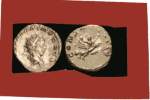We have come across two more names to add to our list of deified mortals from ancient Rome: Diva Paulina and Divus Valerian II.
Paulina was the wife of Emperor Maximinus Thrax and died in 235 or 236 ce. We know very little about her. An inscription gives her name and titles as Diva Caecilia Paulina Pia Augusta. She is given the title of Diva – divine – on Roman coins and is sometimes called thea – goddess – on Greek coins. The title of Pia – pious – might give some indication of her character. She is favorably, if very briefly, mentioned in the surviving text of the Histories written by Ammianus Marcellinus in the fourth century ce, more than a century after her death. Her husband Maximinus appears to have been rather a bad egg and was executed by his own soldiers after a reign of only three years.
Valerian II was never an emperor, but was in line for the imperial succession. He was given the title of Caesar, at the age of 15 or 16, by his grandfather the Emperor Valerian I. His father was the Emperor Gallienus, son and co-emperor of Valerian I. After his appointment to the position of Caesar, Valerian II was sent to the Illyrian provinces, where he died soon after in suspicious circumstances in 257 or 258 ce. Suspician fell upon his principal administrative advisor, a man whose whose name I shall not mention, who promptly started a revolt against Valerian I, but was quickly suppressed. Other than his parentage, we know even less about Valerian II than we do about Paulina. He did not have much time to accomplish anything in his short life. An Imperial teenage boy, a sacrificial victim to the murderous intrigues that had infected the ruling class of that era. And yet, he was rememberd afterward.
Remember that all of the divi and divae are real people, who once walked this earth as mortal human beings. There are stories, whether triumphant, tragic, or trivial, behind their names. Unfortunately, most of the stories have not survived.
Paulina being carried to heaven by a peacock. Auction price in 2013: $750.
A silver antoninianus issued in honor of Valerian II by the mint in Colonia Agrippinensis (Cologne).
Youthful portrait of Valerian II, with reverse showing Valerian being carried to heaven by an eagle. Auction price in 2013: $200.




